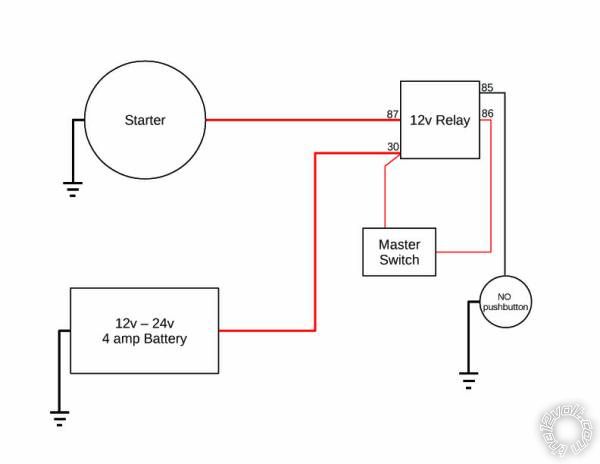This setup is not your typical set-up so let me explain what I'm trying to do:
I have a small 172cc engine that I'm trying to ad a starter to with a master switch and a normally open push-button starter. I'm using a 14.4V 5200mah LiPo battery (for weight reasons). (this is on a paramotor)
Below is the schematic I used to hook everything up:

When I went to test this I got smoke ans sparks and a fried battery. I want to be able to set the master switch to on and be able to push the normally open button to energize the starter. I want the push button to not work with the master switch off.
Is my schematic right? I looked at the relay diagrams and just ended up more confused.
Thanks!
the diagram looks fine. are the wires from battery (power and ground) as well as wires from starter motor adequately sized? how much power does the starter motor draw? is the relay adequate also...may want to use a small solenoid instead? the control leads 85 and 86 don't need to be more than 20 gauge, though one might use 18 gauge for durability.
I'm using 1o gauge wire for the power to the relay and to the starter. 16 gauge to everything else.
I just did a test with another battery I had and could barely get the starter to turn with this set up.
I then switched wires between #30 and #87 (30 now going to the starter) and it fired right up?
I didn't think it made a difference with the relay but I guess it does. The relay is a generic auto relay (12V, 70amp, #384) Why would switching leads make the difference?
I use the same solenoid to isolate 2 batteries in my boat but not sure how I would hook it up for this application. I'm limited on space as well and this is why I went with the relay.
studs on top are 30 and 87, small ones at base 85 and 86...no polarity needs to be observed on 30/87 pair nor 85/86 pair.
Thanks Ween, going to give that a try.
I just want to confirm that your circuit is fine.
Also I am surprised the circuit fried. It may be that the starter takes more than 70A which seems odd for a small engine. (My car's starter only takes 140A, though that's a reduction starter (its normal starter takes 240A), and fyi it's a 1960's 1600cc pushrod engine).
But what is the relay's DC inductive current rating? (See below.)
However a starter could take excess current if faulty (worn brushes, needing a lube, etc) or jams in the engine etc. A low voltage cold contribute to that - ie, not enough to turn adequately.
I assume only the relay fried, not the wires? The warmer the wires, the greater their voltage drop. (Wire warmth is a good way to check for undersized wiring, but don't touch them if they are about to fuse!)
There are also higher rated relays of similar size (eg: Jaycar's AUD$15 FRC6BC-1
Automotive Relay 150A SPDT.
A relay should work... Solenoids are relays though by implication they are for high current and designed for inductive loads (motors etc) and have a high contact force (ie, a big solenoid aka coil).
FYI - googling FRC6BC-1 I see that through rated for 150A, it specifies a DC load rating of 100A @ 12VDC for a resistive load.
[ Now that raises an old thread - is the 150A an AC rating and its 100A resistive-DC rating supports my comment that "
current ain't current" - ie, an AC current rating need not mean the same DC current rating?
]
It seems certain your contacts fused since it fried the battery - ie, they remained closed. Alternatively the relay may have fused/melted and shorted to ground, but that should have fused/blown if the gnd wire was of lighter gauge.
Maybe the fusing was due to unsuitable contact material or a "cheap" or over-specified relay?
Apologies for the extra ramble, but I realise how awkward a
solenoid can be in place of a relay.
All Ween has said is correct, I am merely expanding a bit.
I might try my spare FRC6BC-1 to start my car. Yeah - I now know it probably has under a 100A rating for an inductive DC load (of 140A), but hey, it's only $15, a mere 5% of my weekly income

(LOL).
If I do, I'll let you know how it smokes.
does the relay used have 1/4" tab terminals for the 30 and 87 positions, or are they bigger/wider?
Swapping 87 and 30 should not matter.
Exceptions would include poor contact material, or solid-state relays etc.

 (LOL).
(LOL).